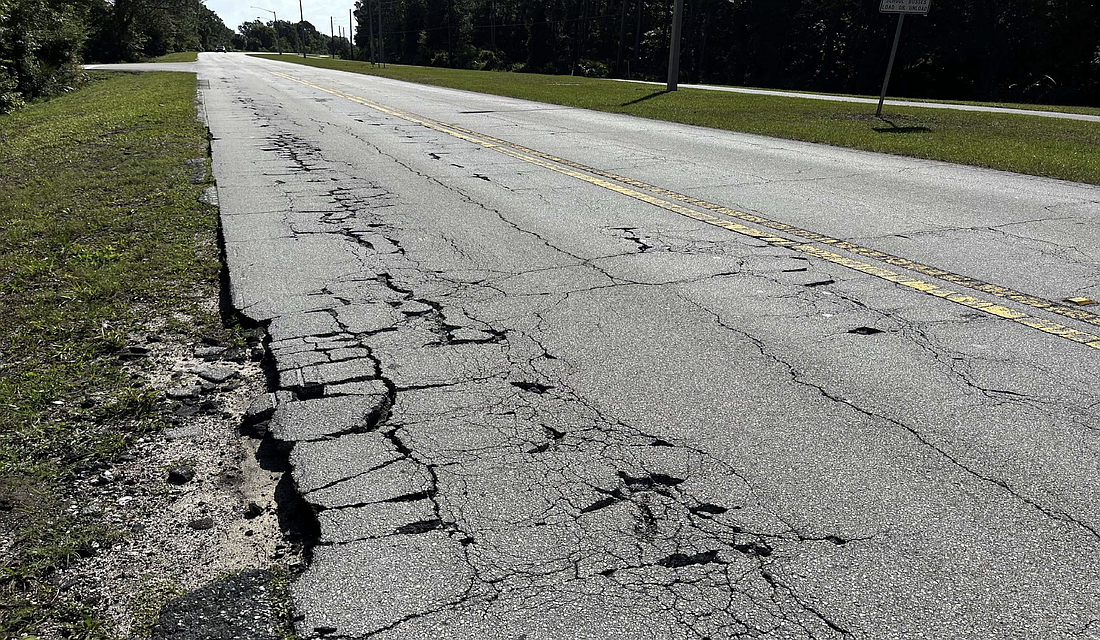- December 15, 2025

Every year for the last five years, Stormwater and Engineering Director Carl Cote has spoken to the Palm Coast City Council about the city’s degrading roadways.
As part of the budgeting sessions, Cote made another presentation in April, once again requesting more money for the city’s resurfacing program.
“Every year, we bring it up to council,” he said. “We identify funding sources or revenues that we do not implement in the city, but there's never been action on council to implement any of those.”
Cote told the City Council that the pavement management program needs $12 million a year just to maintain the roads. That number will just keep climbing, too, the longer the issue is not addressed.
Currently, the program receives $2 million per year, Cote said, and that is after staff added funding from non-essential projects. Cote said the money he requested for the program is just to maintain the roads’ Pavement Condition Index grade of 75, four points lower than its previous score in 2017.
It isn’t just the roads that need attention. Palm Coast’s pipes are nearing the end of their 50-year lifespan, Cote said. And between inflated costs and more frequent failures, the previous budget doesn’t stretch as far as it had.
“We've we've been having at least one [major pipe failure] a year underneath our major roadways," he said. "And it used to be like, one every five years or so."
A planned stormwater utility rate hike and the money Cote requested for the roads would be used for much-needed maintenance.
Cote noted in his presentation that the city has already seen evidence of the roads degrading as the number of work orders increases.
In 2022, there were a total of 155 work orders, said Public Works Manager Marvin Calderon. But the crews have already handled 120 in first the five months of 2023.
Because of the storms last fall, Calderon said, city staff members expect to see more potholes or cracks forming.
“All it takes is one small crack in the road and the water gets underneath that asphalt, and that's what started deteriorating everything underneath the asphalt,” he said.
Even with the increase in work orders, he said, the city’s asphalt crews are able to quickly turn them around.
“We usually respond to the incoming work orders within the hour,” Calderon said.
Fixing the pipes is more intensive.
Cote said stormwater and engineering staff members are responsible for inspecting around 3,000 pipes and try to assess each pipe every other year, marking which ones needs replacing or new linings.
Linings extend the life of the pipe, Cote said, and are less expensive than replacing the pipe entirely — especially when pipes are under roadways.
It’s expected that pipes will age and need replacing. What is abnormal about Palm Coast’s pipes, Cote said, is that all the pipes in the city were laid down at around the same time by the International Telephone and Telegraph Corporation in the 1970s and '80s.
That means multiple pipes are in danger of failing at once, he said.
"We're at the point where we want to increase our quantity of replacements per year, so our rate of failures doesn't increase," Cote said.
Palm Coast Mayor David Alfin said ITT planned for Palm Coast to have a population of 250,000, but he didn't think anyone could have predicted how quickly it was going to grow over a short period of time.
"I do believe that the original plan ... never identified a way to pay for the ongoing maintenance and repair of aging infrastructure," he said. "This city is suffering from aging bones, which we're not well prepared for."
Cote said staff has already tried to find creative solutions for funding the stormwater projects and the road maintenance program to avoid tax increases or fees.
“They're my tax dollars too,” Cote said. “We look hard at every penny we spend. We're not looking to be wasteful at all.”
Alfin said he thinks the city’s staff is already doing an exceptional job counting every penny.
“I would put our staff up against any staff in any city throughout the state, in terms of their efficiency, their creativity, and their work ethic,” Alfin said.
But not all City Council members agree.
In a May 16 City Council meeting, the council approved another increase to residents’ monthly utility bill to fund pipe maintenance.
On Oct. 1, the monthly utility bill will go up to $28.34 from $22.07 and increase every year over the next five years.
Vice Mayor Ed Danko and Council Member Cathy Heighter both voted against the stormwater rate hike.
“... My suggestion is do what the rest of us are doing,” Danko said at the meeting. “Learn how to tighten your belts; learn how not to waste money.”
Nobody at the city — staff or council members — wants to increase taxes, Alfin said. But he hopes the city won’t need to.
On June 13, the City Council will hear a presentation from the county's property appraiser on property taxes and the millage rate for the fiscal year 2024 budget.
Alfin said he wants to know how much money Palm Coast will receive from new construction and new residents.
"That would not constitute a tax increase. Those would be new taxes," he said. "That's one of the benefits of growing — that you have new tax dollars that were not part of the prior budget."
Based on Palm Coast's growth rate, Alfin said, that may be a significant amount of revenue.
Regardless, he said, he will not compromise on safety.
“I will not sacrifice public safety," Alfin said. "Those are, in my opinion, at the very heart of every possible component of quality of life.”